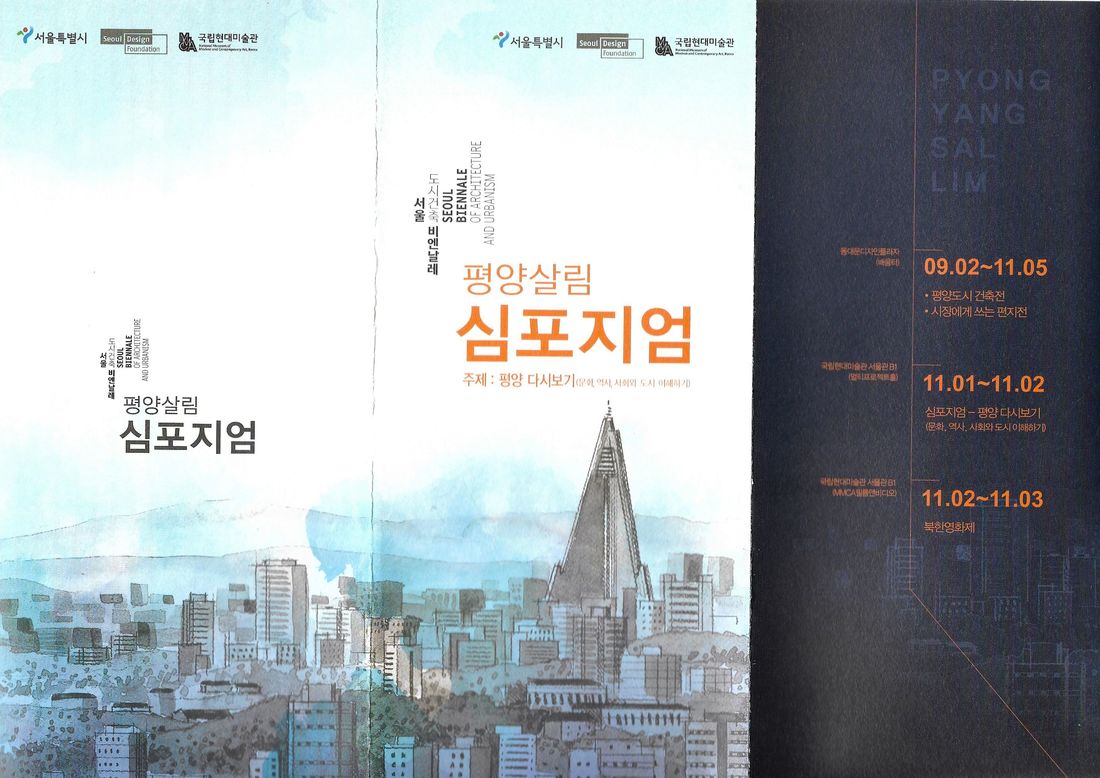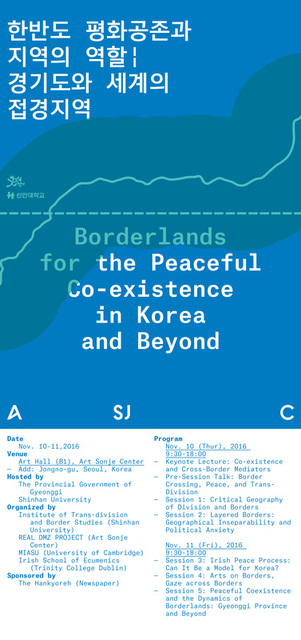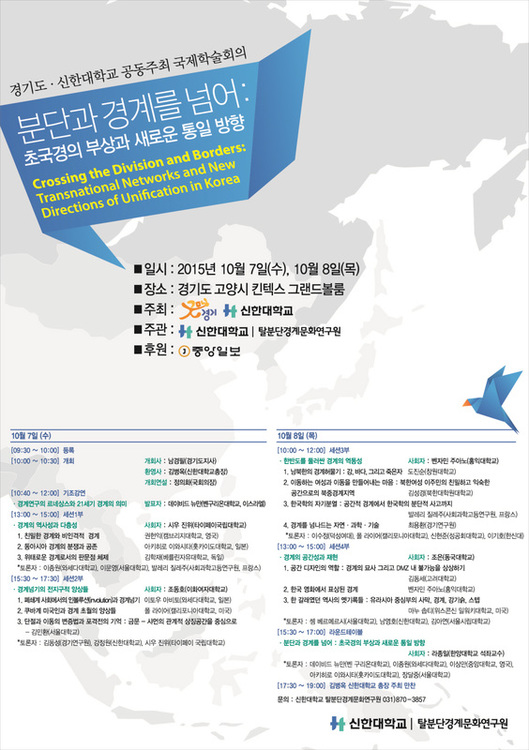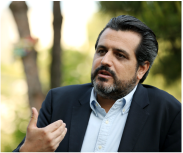|
I will be a discussant at the 2nd Shinhan University international conference on Friday 12 November, held at Art Sonje (Seoul). This year theme is “Borderlands for the Peaceful Coexistence in Korea and Beyond".
This week, Wednesday 7th and Thursday 8th October, at the conference "Crossing the Division and Borders" organized by Shinhan University, at Kintex (Ilsan), I will moderate a session Thursday morning and present a paper the afternoon about the representation of the border in South Korean cinema. The Representation of the borders in Korean cinema (1998-present) I had the pleasure to discuss two exciting papers, Lee Seung-Ah's (UCLA) on Yi Sun-shin representations in popular culture, and Elli Kim's (UCLA) on South Korean action spy movies after 2008.The 8th Kyujanggak International Symposium on Korean Studies
Documents are not just a historical legacy that reflects past ideas or mentalities; they also give rise continuously to new interpretations, and sometimes even interact with historical memories and serve to reshape them. The purpose of this symposium is therefore to question the contemporary implications of the documentary heritage of Korea. Historical changes in the meaning of recording or producing documents; the manifold social tensions that exist between recording and remembering; the diversity and connotations of various new media for recording history; problems and controversies surrounding the interpretation of historical records; the specificity of the Korean documentary heritage in its global context; these are just some of the subthemes that could be explored. For this purpose, we have invited scholars from around the world to share their thoughts on various agendas surrounding the main theme. Yongusil 33: The Sun, the Arrow, and Benjamin Joinau
BY ROBERT WINSTANLEY-CHESTERS | MAY 07, 2014 | Click on the title to see the original article. As academics and analysts, we read a large track of material and attend a large number of workshops, conferences, and other such intellectual gatherings. At the Sixth World Congress of Korean Studies in September of 2012, held at the idyllic Academy of Korean Studies in Seongnam, I heard a conference presentation that stopped me in my conceptual tracks and supported a dizzying connectivity between concepts I had previously absorbed and historical material I was currently processing for my own doctoral dissertation. Benjamin Joinau of EHESS, Paris delivered a presentation entitled “The Sun and the Arrow: A Topo-myth Analysis of Pyongyang” that turned my head. Joinau utilized the core analytical tool box of psycho-geography while coupling it to an acute sense of space and place akin to the most urgent and forthright of an anthropologically minded activist: urban geographers. Pyongyang lived and breathed in Joinau’s presentation, its histoire and terroire vibrating in conjoined narratological connection. Methodologically activated through a spatialization of Durrand’s diurnal and nocturnal mythodology via James Duncans’s socio-semiotoics, Joinau’s psycho-geographic reconfiguration of urban Pyongyang’s physical and spiritual axes was extraordinary. We watched and listened as he revisioned the construction and organization of the physical spaces of Pyongyang from those previous and historically familiar, grounded first in the needs and structures of the Yi dynasty, (“Pyongyang retained the dense and diversified fabric of its ancient origins….”) and secondarily in the co-option, ambition, and coloniality of Imperial Japan and submissive Chosun, through the disruption and destruction of war to new, more assertive re-orderings undertaken at the behest of revolution. Pyongyang and North Korea’s revolution was to play out in its urban geography, ”etching the official ideology… into the city’s layout.” It was to be commemorated in monolith and edifice and writ large in monumentality. This was urban geography manifesting not only revolution and ambition, but inherently and almost primarily glory. Joinau has envisaged an urban landscape and landscapes of actuated, embedded, acute glorification. Here a geographic and “ideological polygon” form axes of orientation echoing what Joinau terms “the sun” and the arrow.” Pyongyang is thus seen as a city “… symbolically and politically under the… eye of the Father, the Sun on Earth.” Joinau’s work through this intriguing interplay of symbol, semiotics, mythos, and cityscape provides a fascinating physical urban echo to Heonik Kwon and Byung-ho Chung’s more theoretic conceptualization of a North Korean politics of theatrics and charisma. Joinau has surely produced the vital kernel of what must be an absolutely key work of scholarship addressing the impact of politics and mythic narratology upon the physical landscapes of urban environment, twinning in the wake of Kwon and Chung, urban glory with charismatic rurality. The piece can be found in the new issue of the Sungkyun Journal of East Asian Studies (part of SungkyunKwan University in Seoul’s Academy of East Asian Studies), edited by the esteemed Dutch Koreanist Boudewijn Walraven. |
Benjamin Joinau's
Texts - Articles - Books - Presentations - Lectures - etc. Catégories
Tous
|
MESMOTSMESMONDES




 Flux RSS
Flux RSS
